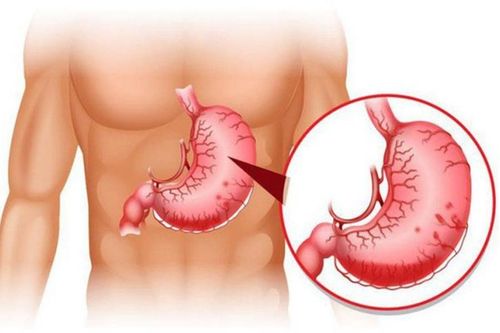This is an automatically translated article.
Cysts, fibroids or polyps are benign vocal cord tumors common in all subjects, especially those who need to use their voice a lot in life such as teachers, singers, tour guides... Currently, laparoscopic resection of small benign vocal cord tumors is the most effective method to treat these tumors.1. Overview of benign vocal cord tumors
1.1 Vocal cord cyst Vocal cord cyst is a mucus-filled tumor inside and an outer sheath that develops on the folds of the vocal cords. Usually, vocal cord cysts appear only on a certain fold.Causes of vocal cord cysts are relatively diverse and abundant, of which the most common are:
The epithelial layer is trapped in the vocal folds. The patient abuses his voice too much. Caused by the bacterium Streptococcus pseudopneumoniae. When having a cyst on the vocal cords, one of the most obvious manifestations in the patient is a persistent hoarseness and may be accompanied by a number of other symptoms such as:
Difficulty speaking, needing to use force when speaking. Fatigue and neck pain when speaking. Singers will have the phenomenon of sudden loss of voice, difficulty going up to a certain range... 1.2 Vocal nodules Vocal cystic fibrosis is a type of small benign vocal cord tumor that forms on the vocal cords, usually results from the rubbing of the vocal cords against each other during pronunciation.
Vocal cord nodules are more common in female, young, or adolescent male patients. In addition, other occupations that need to use the voice such as singers, teachers ... also have a high risk of forming vocal cord nodules.
In terms of symptoms, vocal cord nodules often cause hoarseness. The degree of hoarseness will depend on the size and degree of compression of the fibrous particles.
1.3 Vocal polyps Vocal cord polyps are benign and have little chance of turning into malignancy. In the early stages, vocal cord polyps can be treated with a number of drugs to limit symptoms but cannot be completely cured.
Vocal polyps when growing larger will cause many obvious symptoms:
Hoarse voice, cloudy sound. Dry throat is itchy, uncomfortable, and often feels like a foreign object in the throat. At this time, the most radical way to remove these vocal cord tumors is surgery.

Giọng khản đặc, âm thanh đục là những triệu chứng điểm hình của người bệnh có polyp dây thanh to
2. Learn about laparoscopic surgery for small benign tumors of the vocal cords
Small benign tumors of the vocal cords are performed with laparoscopic surgery with the aim of removing benign tumors on the vocal cords (cysts, fibroids or polyps), thereby restoring the function of the vocal cords. patient's normal tone.3. In which case is small benign tumor of the vocal cords indicated?
Surgery is often recommended when the patient has a benign vocal cord tumor such as:Vocal cord cyst. Vocal polyps. Vocal cord fibers. Besides, surgery is also contraindicated for the group of patients who can't have anesthesia/anesthesia for health reasons or are not eligible for surgery.

Phẫu thuật thường được đề nghị khi bệnh nhân có u dây thanh lành tính như u nang dây thanh, polyp dây thanh, hạt xơ dây thanh
4. Laparoscopic surgery for small benign tumors of the vocal cords
The main performer of vocal cord tumor surgery is a specialist doctor I Ear - Nose - Throat and above, with extensive training in laryngeal surgery. In addition, the team performing endoscopic vocal cord surgery will include:Another ENT specialist with a supporting role. Anesthesiologist and technician. Nursing in the Department of Otolaryngology. Checking the patient's record and condition: Before surgery, the doctors will perform a check through the examination steps and evaluate the basic test results as well as the previous laryngoscopy results to:
Assess the patient's local health and respiratory status to determine the appropriate anesthetic/anesthetic method. Locate the patient's vocal cord tumor. Techniques used in surgery: Step 1 – Anesthesia Normally, the patient will be anesthetized for intubation. In case the patient is not qualified for anesthesia, the patient will be given local anesthesia. Step 2 – Laparoscopic surgery to remove small benign vocal cord tumors The doctor will use a Karl-Storz laryngoscope to expose the larynx and evaluate the tumor in terms of location and size. Use surgical forceps and microsurgical scissors to remove the vocal cord tumor below the vocal cord mucosa, then flatten the free margin. Hemostasis by electrocoagulation.

Thông thường, khi phẫu thuật bệnh nhân sẽ được gây mê đặt nội khí quản
5. Monitor postoperative complications and how to handle them
Laparoscopic small benign tumor resection does not have special complications, however, there are some common risks of surgical surgery such as:Bleeding: sphincter to stop bleeding. Surgery causes damage to the vocal cord muscle layer. Currently, Vinmec International General Hospital, with its outstanding advantages of a team of elite doctors and the modern and advanced medical equipment system, has become a reliable address when patients Endoscopic surgery is required to treat many different diseases.
With a high level of expertise and experience, each doctor at Vinmec hospital is always capable of handling simple to complex surgeries, easily improvising before any unexpected risks occur. out on the operating table. This gives patients a high success rate and minimal complications when performing surgery.
Besides, patients after surgery will be cared for and monitored in a high-quality ward, providing maximum support for the recovery process.
For more examination and advice on laparoscopic small benign tumor of the vocal cords of Vinmec International Hospital, you can book an appointment here.
MORE
Is acute laryngitis dangerous? Learn about soft cartilage in the larynx Causes and treatment of chronic laryngitis













